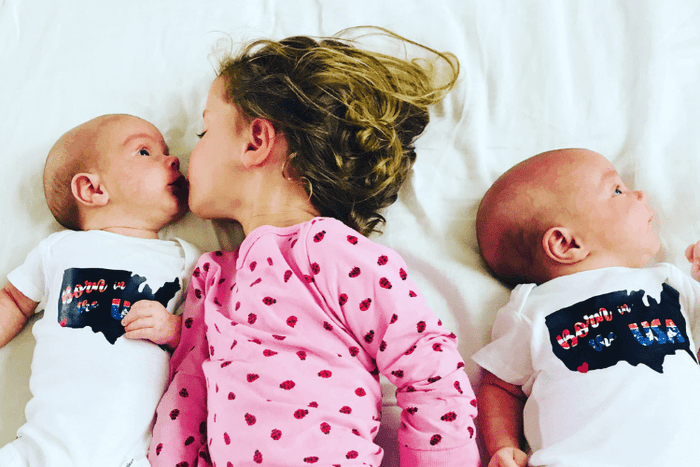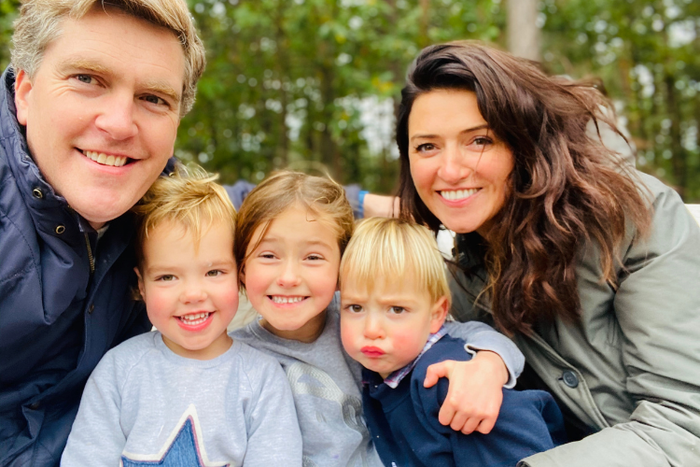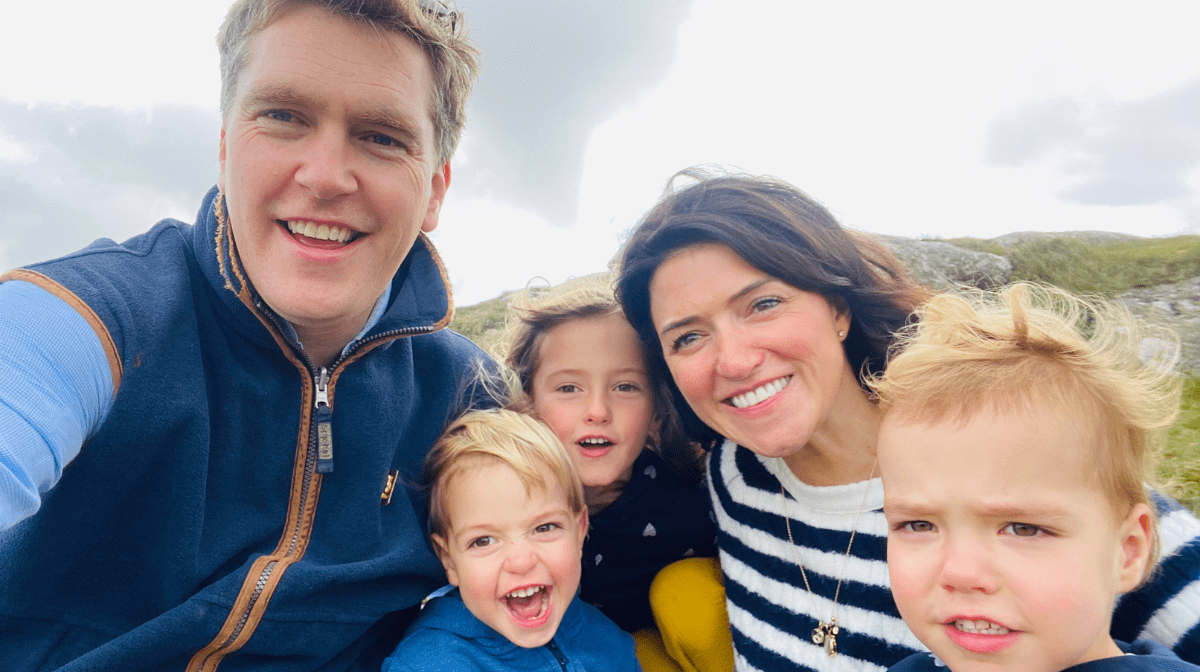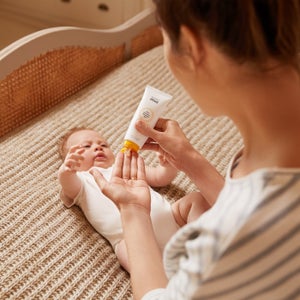
Surrogacy was once considered a 'taboo' subject, however it has since become an increasingly popular and successful route to parenthood. We spoke to Anna Buxton, coordinator at @officialmysurrogacyjourney to ask her about the struggles she faced whilst trying to get pregnant and how this led her and her husband Ed to explore gestational surrogacy.
Read on to discover Anna's experience with gestational surrogacy, what the process involves and her advice for couples/individuals who are also going through the surrogacy process.
1. For our readers who aren’t so familiar with surrogacy, can you explain a bit about what surrogacy is and the different types?
Surrogacy is where a woman carries and gives birth to a baby for another couple or a single person.
There are two types of surrogacy, gestational surrogacy and traditional surrogacy. Gestational surrogacy, most commonly what people are referring to today when talking about surrogacy, is when the egg comes from either the intended mother or an egg donor, and the sperm is from the intended father, or a sperm donor. There is no genetic link to the surrogate.
Traditional or straight surrogacy is the use of the surrogates’ egg with sperm from the intended father, or donor. So, there is a genetic link to the surrogate.
In any surrogacy arrangement, as prospective parents, you are always referred to as the “intended parents”.
2. Following a number of miscarriages, you were diagnosed with Asherman’s Syndrome and had to undergo a number of operations. Can you tell us about this condition and how did it prevented you from becoming pregnant?
Like all women who turn to surrogacy, it was after a long, painful and complex gynaecological and obstetric history. Ed and I got married in December 2011, I was 32 and Ed was 34. We both wanted to try for a family straight away, and so set to it! Three months later, I was pregnant and we were thrilled. But at eight weeks, an early scan revealed that I had a missed miscarriage. The pregnancy was over but my body hadn't got rid of it and so I required a D&C to remove the pregnancy.
We were told that as soon as my period started, we could try again. The next month we were pregnant. It was the same month that we moved into the house we had bought after getting married and it all just felt right. We put the miscarriage behind us and excitedly looked forward to a new home and a new pregnancy. But, history repeated itself and at eight weeks I had another missed miscarriage and subsequent D&C.
A few months later my periods had not returned, I was in pain and I just knew something wasn't right. I was diagnosed with Ashmerman’s Syndrome. The formation of adhesions, or scarring, in the uterus which meant that my periods stopped because the scarring prevented the lining of my womb from developing each month. Left untreated, it can be very difficult to get pregnant because an embryo does not have a healthy lining in which to implant. Over the course of 16 months, I had five more operations to remove the scarring from my uterus. Having a baby had once felt so normal and achievable. It now felt a very long way away.
After each operation, the scarring would reform and after the fifth procedure, my surgeon said that he could not operate again. The damage to the lining of my womb had been too severe and he felt it was wrong to put me through any more surgeries. He told me that I would never carry a pregnancy.
"For lots of couples, turning to surrogacy can be a much longer and harder decision. If you aren’t told definitively that you can’t carry a pregnancy, rather that you may not be able to, and given that surrogacy is still shrouded in misinformation, it can just be a much more difficult decision."
3. You were then told that the only option to have children was via a surrogate. Can you tell us about your experience with IVF and how this affected your mental and physical health?
Because I couldn't carry a pregnancy, the next step for us was to create embryos via IVF. The needles, the appointments, the blood tests, the internal scans are all unpleasant, but for me I found the loneliness of IVF the most difficult part. Every round I did, I did it without telling my colleagues at work. For two weeks, I would have to pretend that everything was normal despite the daily surge of hormones coursing through me. After the collection, I jumped every time the phone rang thinking it might be the embryologist with news of my precious embryos.
I think one of the cruellest but equally remarkable parts of infertility and IVF, is that the more negatives you have, the more failed IVF rounds, the more negative pregnancy test results, or miscarriages, the less you can ever believe is going to happen for you, yet you do find the strength to keep trying. I cherish that strength and reserve I found during this journey and when something isn’t going quite right now, I remember I’m capable of more than I think.
What kept me going was my relationship with Ed. Infertility of any kind changes you as a couple. That level of pain and anxiety can never be forgotten but the resilience, the patience and the strength you find together ends up defining your relationship
4. Was gestational surrogacy an instant decision for you and your husband, or did it take some consideration?
The conversation around surrogacy started with our doctor. Given that we had viable embryos and that I had categorically been told I could not carry a pregnancy, surrogacy was the next natural step for us. For any women, surrogacy is not a choice, a luxury or the easy option but we did take comfort in the fact that we still had options.
It sounds strange but we were lucky in that we were told 100% I could not carry. For lots of couples, turning to surrogacy can be a much longer and harder decision. If you aren’t told definitively that you can’t carry a pregnancy, rather that you may not be able to, and given that surrogacy is still shrouded in misinformation, it can just be a much more difficult decision.
5. Why did you choose gestational surrogacy in India and the US, rather than at home in the UK, and how did the process work?
We wanted to find a surrogate in the UK. I wanted to be able to get to know our surrogate, to build a friendship and be part of the pregnancy. We threw ourselves into research and it soon became very clear that there was no one clear answer. Surrogacy is a complex emotional, physical, legal and financial process. It was unbelievably daunting. We spoke to the surrogacy organisations and went to a conference, where we spoke to women who’d been surrogates as well as couples who’d had babies through surrogacy. We also spoke to lawyers about the legal framework.
We looked at the independent route which is largely Facebook groups where surrogates and intended parents could meet. The uncertainty around how long it would take to find a surrogate in the UK – we were told a minimum of 18 - 24 months, but possibly much longer and the lack of professional support for both intended parents and surrogates, ultimately drove us to looking abroad. Like many women who arrive at surrogacy, we'd already had a hard time. It felt like a holding pattern and, after everything we’d been through, we weren't sure we could handle that.
At that time the two main destinations for surrogacy were India and the US. The US was out of the question because the gestational surrogacy costs were so high, so we researched India. While I was incredibly comfortable with the idea of surrogacy, Ed and I always agreed that our need to have a family would never come at the expense of another woman's wellbeing. We also knew that any child we brought into this world, deserved a story that was responsible, ethical and something that we could all be proud of.
We decided to visit India ourselves. We went to ten clinics in three cities and we spoke to charities, lawyers and surrogates. We asked questions like how much surrogates are paid and do they receive the entire fee, is there a written agreement between parents and a surrogate, is it in her native language, does she have independent legal representation? We found an organisation that was doing things differently, where women were empowered to make their own decisions and were medically, legally and emotionally informed. We decided to move forward and flew home to begin the process.
We were matched with our surrogate, Chaphala, by an agency and doctor and were then introduced via Skype. Once we had all decided we were happy to move forward and had finalised the legal requirements, we started the IVF stimulation process in the UK, and then flew out to India to have my eggs collected and the embryos created. It was at this time that we first met Chaphala in person. I remember our first meeting, we were both so nervous! I was so worried that she wouldn’t like us and she felt exactly the same. But as soon as we started talking about families, about her children and about our want to build a family, we chatted happily and it felt right.

We flew home after the transfer and all we could do was wait for the blood test two weeks later. For two long weeks, you can’t do anything but just wait and wonder if another woman thousands of miles away is pregnant with your baby. Then the call came…congratulations!
We received weekly updates from the doctor and Chaphala via email and every two weeks, Chaphala would have a scan and the results were emailed to us. Because the communication was so regimented, I realise now with hindsight, that it made the pregnancy easier. I still worried every minute of every day but I knew that I just had to get through each week and wait for my updates. Thankfully, the pregnancy was uneventful and at 38 weeks we flew to Delhi for Chaphala’s final scans, appointments and then of course to be there for the birth.
After Isla was born, we had to live in Delhi for six months while we waited for her UK passport. Delhi is not an easy place to live, let alone with your first baby, but we were finally a family.
When we started to think about a sibling for Isla, India had stopped allowing foreigners to have children through surrogacy. The UK was not an option because one charity had closed their books to intended parents and another was only taking on intended parents who didn’t have children. We felt that the US was our only option.
Finding a surrogate in the US is a bit like dating! Surrogates write a profile, you write a profile, and if you match, you go for it! Obviously, it is much more complicated than that and there are so many factors to consider but the most important factor is ultimately respecting each other. Once you’ve seen a profile, if the surrogate agrees you meet over Skype. We spoke to a number of women but when I first met Holly, I knew she was the one. You can’t tell from one phone call if someone is perfect, but I knew I liked her, I liked her reason for doing surrogacy, her husband joined the call and was supportive, and her children knew - for them, it was a family affair. She had a large support network of friends and family who all supported her. Given how far apart we were, that support network was really important to me.
On our trip to San Diego to create and freeze our embryos, we were able to meet Holly and her family. We had arranged to meet for brunch between our hotel and where they lived. And so one Sunday morning, we turned up at a diner off the 805, me, Ed and Isla and there was Holly, her husband and their three children.
After that first meeting, we were all excited to move forward and committed to doing so. It is a complex process but we were surrounded by highly experienced medical and legal professionals in surrogacy and about six months later our embryos were transferred to Holly.
6. How much involvement did/can you have in your surrogate’s pregnancy including their diet, exercise, lifestyle and so on?
I always tell people that you should only consider surrogacy if you think you can put all your trust in another woman. I don’t think it is appropriate or respectful to try and stipulate how your surrogate looks after herself during the pregnancy. I have met many surrogates over the years and what they have all had in common is that they are dedicated mothers. I believed that both our surrogates would care for our pregnancy in the same way they cared for their own, and that they did.
7. Pregnancy can be a time of worry and confusion; how did you and your husband deal with this not carrying your own child?
I didn’t! Having never been pregnant, I can’t compare that worry but for me our two pregnancies were tough. Knowing that your baby, or babies, are in this world, albeit in utero, and that you aren’t there for them, that you are thousands of miles away is a very difficult concept to describe. I would never downplay how hard a surrogacy pregnancy is.
The highs are so high, your first scan, hearing that heartbeat, getting to each milestone is immense. You are 100% emotionally attached to that baby yet physically you are totally removed. Yes, you can do everything you can to support your surrogate but tangibly you have no role, or control, in the pregnancy. It is hard.
8. What were the births like and were you and your husband able to be present?
For Isla, we were not in the room but next door. As soon as she was born, she was bought through and placed in my arms. It felt like every dream I'd ever had, had come true.
For the twins, one of the things that Holly and I loved to talk about was our birth plan. We had it all agreed and worked out! Then at 34 weeks, the day I’d stopped working and a week before we were due to fly, Holly went into labour. I got a call from the doctor saying, “Anna I don’t want to alarm you but we are doing a C-section in 20 minutes”.
An hour later, two nurses called to say they were the NICU nurses responsible for our babies that night and did they have names. I managed to get a flight out to San Diego the next morning and was with Olive and Art about 18 hours after they were born. It was so far removed from what Holly and I wanted, but both the babies and Holly were healthy, and for that, we will be forever grateful.
As a new family of five, we stayed in San Diego for two months and enjoyed life in Southern California. Although surrogacy is a well-trodden path in California, the paperwork is still complicated, from agreeing on the medical insurance to applying for American passports. The stay also gave us the opportunity to spend time with Holly and her family. We all felt it important for her children to see us with the babies, the family they created, and appreciate the magnitude of what their mum had done.
"I always felt guilty and sad that Ed would never see me pregnant and that I was less of a woman because of it."
9. After years of trying, you finally now have your 3 children Isla, Olive and Art. Do you think surrogacy can change the relationship you have with your children and will you share your surrogacy journey with them?
No! However your children are brought into this world, whether you are genetically linked on or not, I believe has no impact on your relationship. When you finally have your children, however you do, you realise that the ones you have are the ones you were meant to have and the journey to get there finally makes sense.
Of course, honesty is key. From before Isla could understand it, we have talked about how she came into this world and continue to do so proudly, repeatedly and consistently. She knows that my tummy is broken and so another mummy helped us by growing Isla in her tummy. And, we are doing the same for Olive and Art. The children know that it took a lot of love to bring them into this world.
10. Is there anything you wish you had known before gestational surrogacy?
Never did anyone suggest it was my fault but I went through this whole journey feeling like it was my fault, because it was my body which had failed. I always felt guilty and sad that Ed would never see me pregnant and that I was less of a woman because of it.
If I knew then what I know now about what it means to be a mother, I don’t think I would have felt like that. To me being a mother is about being there every day for my children, doing the best I can every day, probably making mistakes every day, but being there for them. I wish I hadn’t carried that guilt for such a long time.
11. What advice would you give to couples/individuals who are considering or going through the surrogacy process?
As anyone who has been through IVF knows, it is physically, emotionally and financially draining. The stress and cost of surrogacy on top of that can make it feel like an insurmountable prospect. Find people who have been through surrogacy and professionals who can support you. I now work for My Surrogacy Journey, a new non-for-profit surrogacy organisation, which supports people going through surrogacy.
We provide emotional, practical, legal and logistical support through the entirety of a journey. Our aim is to not just get people through a surrogacy journey, but to help them enjoy and cherish their pregnancy like any pregnancy should be. If My Surrogacy Journey had been around when we were building our family, it would have saved us time, heartache and money.
When we first realised that surrogacy was going to be our route to parenthood, it felt like a very sad last resort. I realise now that it was the light at the end of the tunnel. Surrogacy has given me the family I always dreamed of and three daily reminders of how amazing women can be.
Want to know more about Hyperemesis Gravidarum? Read about Pinar’s experience with the debilitating condition here.









